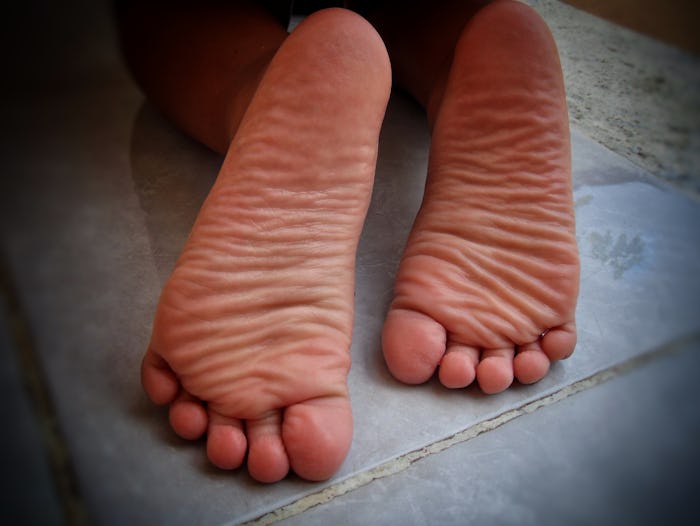News

Expert Explains "COVID Toes," A Condition That Could Be A Sign Of Coronavirus In Kids
With more than 2.5 million confirmed cases of COVID-19, the respiratory illness caused by the novel coronavirus, around the world, parents and caretakers are, by now, well aware of the virus's more common symptoms, like fever, fatigue, and cough. Now, however, a growing number of doctors and dermatologists have reported seeing a potential new symptom: COVID-19 toes. But just what do "COVID-19 toes" look like and how might they be an early sign of the novel coronavirus?
Dr. Ebbing Lautenbach, M.D., chief of the division of infectious disease at the Perelman School of Medicine at the University of Pennsylvania, tells Romper "they seem to be part of the constellation of symptoms that we’re getting a better sense of in patients with COVID."
"They certainly don't happen in everybody, but they have been recognized in a subset of people with COVID," Lautenbach says. "Interestingly, they tend to be seen more commonly in kids and young adults with COVID."
As the number of COVID-19 cases continues to rise around the world, a number of doctors and dermatologists have reported seeing purple or reddish blue lesions on the toes or fingers of some confirmed or suspected COVID-19 patients. "Typically [they] tend to be on the tips or the pads of the digits, although you can see them on the upper side of the toes as well," Lautenbach says. "In addition to their color, they're characterized by sometimes being painful. Sometimes they can feel hot or can give you sort of a burning sensation."
According to the International Federation of Podiatrists (IFP), one of the first cases of "COVID-19 toes" to be reported was that of a 13-year-old boy who sought treatment for the skin manifestations from Italian dermatologist Francesco Mazzotta. Within days of seeing Mazzotta, the boy tested positive for COVID-19, according to the IFP. Additional cases of COVID-19 toes have since been reported by a number of other Italian and French doctors as well as the Spanish General Council of Official Podiatrist Colleges.
Doctors now suspect the condition may be one of the earliest manifestations of a COVID-19 infection. "We now recognize that sometimes people have a loss of their sense of smell early on with COVID," Lautenbach tells Romper. "You sort of view COVID toes in somewhat the same way, because sometimes that's either the only symptom that you ever get of COVID or it's the earliest symptom that you ever get, meaning you get these lesions on your toes and then you progress on to develop other symptoms."
While the skin condition has been found to occur in adults, Lautenbach, the IFP, and the Spanish General Council of Official Podiatrist Colleges have all noted that COVID-19 toes are more commonly seen in children and adolescents. "Early anecdotal reports suggest COVID-19 occurs in the feet and in particular has been found in the feet of children and young people prior to any other symptoms appearing," the IFP said Tuesday in a press release announcing the launch of its COVID-19 Foot Registry, which aims to track potential symptoms or signs of COVID-19.
But just what causes COVID-19 toes? While the condition resembles pernio, an inflammatory skin condition that manifests as painful bumps or red- to violet-colored patches on the hands and feet after exposure to cold temperatures, doctors aren't yet completely sure what causes it.
At the moment, Lautenbach says there are two theories of thought behind its cause. "The first is that, overall, there's a pretty brisk inflammatory response to COVID infections," he says. "So, one of the thoughts is that this just happens to be a localized inflammatory response."
The other theory is that the lesions are caused by small blood clots occurring in veins around the toes or fingers. "Overall in COVID, we're getting a sense that there are patients who have blood clotting issues, meaning they're more likely to develop clots in the blood vessels in coincidence with having a COVID infection," Lautenbach says. "But the truth is no one knows exactly what the underlying mechanisms for this are." Similarly, Lautenbach says it's too early for doctors to determine how common COVID-19 toes are or even how often they occur among COVID-19 patients.
While there's certainly more to learn about this particular skin condition, COVID-19 toes don't appear to be particularly dangerous. According to Lautenbach, cases of COVID-19 toes usually tend to resolve on their own in an average of seven to 10 days with no long-term effects. Because there's no specific treatment or course of management for COVID-19 toes, Lautenbach recommends parents don't immediately rush off to the hospital if they find the lesions on their child. Instead, he suggests sending a photo of the affected area to their pediatrician and then proceeding to keep a closer eye on whether the child develops any further symptoms.
"Parents should recognize that this could be, I mean, it could also be due to trauma or something like that, but this is one of the manifestations of COVID," Lautenbach tells Romper. "In terms of early management, there's nothing that you would do differently except perhaps to keep a slightly closer eye on your child for developing fevers or respiratory symptoms or things like that."
If you think you’re showing symptoms of coronavirus, which include fever, shortness of breath, and cough, call your doctor before going to get tested. If you’re anxious about the virus’s spread in your community, visit the CDC for up-to-date information and resources, or seek out mental health support. You can find all of Romper’s parents + coronavirus coverage here, and Bustle’s constantly updated, general “what to know about coronavirus” here.
Expert:
Dr. Ebbing Lautenbach, M.D., MPH, MSCE, chief of the division of infectious disease at the Perelman School of Medicine at the University of Pennsylvania.